Repotting a Jade Plant

Q: Should I consider repotting my jade plant into a bigger container? asks Birds & Blooms reader Sandy Crooms
Garden expert Melinda Myers writes, “Cacti and succulents have relatively small root systems for the size of the growth above ground. Moving a plant too often or keeping it in a container too big can result in the potting mix staying wet, leading to root rot. It’s time to transplant when the roots begin to encircle the rootball or new growth is stunted. Your jade plant appears to be thriving, but it looks as if it has settled in the container. This is not a problem. Some gardeners prefer to adjust this by adding soil to the bottom of the pot. Just add a bit of fresh cactus and succulent potting mix in the bottom of the container, loosen roots if needed, and set the rootball on the additional potting mix. (Psst—here’s how to find the best potting soil for every type of plant.) The new soil level should be 1/2 to 1 inch below the lip of the container.”
Did you know—you can grow new jade plants and other succulents from cuttings.
Ficus Elastica (Rubber Tree) Repotting

Q: What’s this plant, and should it be repotted? asks Birds & Blooms reader Kristen Eppley
Melinda says, “How lucky to have a large rubber tree (Ficus elastica), especially one that has flowered. It would benefit from repotting. (Didn’t move your plant in time? Here’s how to fix a root bound plant.) Move it to a pot only one size larger to prevent root rot, as an oversized pot holds more soil and tends to stay wet longer. Consider waiting to repot your rubber tree until early spring, when the days are longer and the light is more intense. The sunnier growing conditions will help the plant recover from repotting more quickly.”
Next, discover succulents that attract pollinators.
Why Plant a Silky Dogwood Shrub

Like most dogwoods, silky dogwood looks fantastic in every season and birds love it.
The show starts in spring when the white flowers emerge. The blooms stay through part of the summer and dot the light green foliage. The oval leaves darken and the fruit starts to develop as summer ends.
The fall leaf colors are striking, but don’t last long. The real attraction is the berry-like drupes that birds love. Watch for them to swoop in, grab a drupe and fly off.
In winter, some cultivars offer bright red branches that stand out in snowy or drab gardens. Check out more winter interest plants to add color and beauty. to your yard
How to Grow Silky Dogwood
- Cornus amomum
- Common name: Silky dogwood
- Zones 4 to 8
- Light needs: Full sun to part shade
- Size: 6 to 12 feet tall and wide
Silky dogwood is native to the eastern United States and works well in woodland and wetland gardens or areas where it can spread. It forms dense thickets without regular trimming and makes a fantastic hedge.
As a bonus, it can be planted in wet soil or near black walnut trees and deer tend to avoid it.
Plant these native trees that attract birds.
Attract Birds With This Native Shrub
Berry-eating birds like gray catbirds, rose-breasted grosbeaks and robins love this shrub.
Watch for white berry-like fruits to appear in the middle of summer. They ripen and turn blue in late summer. The fruit looks great on this large shrub but only last as long as it takes for backyard visitors to scoop them up.
Discover 7 backyard birds that eat berries.
Silky Dogwood Vs Flowering Dogwood

Dogwood varieties, like silky and flowering dogwood, share many characteristics. It can be hard to tell them apart. Birds & Blooms reader Vincent Drexler of Canal Fulton, Ohio, asks, “This plant was labeled as a dogwood. What is it actually?”
Garden expert Melinda Myers writes, “The plant is a type of dogwood. But it’s not the flowering dogwood (Cornus florida) you may have expected. Your shrub is most likely silky dogwood (Cornus amomum), a suckering shrub that grows 6 to 10 feet tall, with small white flowers and purplish stems. Take a closer look at the growth habit, stems and leaves to confirm your plant’s identity. Compare these features to detailed descriptions on botanic garden or educational websites.”
Next, check out the top 10 summer flowering shrubs for full sun.
Looking for some new additions to your own wardrobe, or need a perfect gift for you favorite owl fan? These owl shirts will fit the bill! Some of the designs are realistic and include identifiable species, while others are more fun or stylized. There should be something here for everyone.
Also check out these unique owl gifts we can’t resist.
1. You’re a Hoot
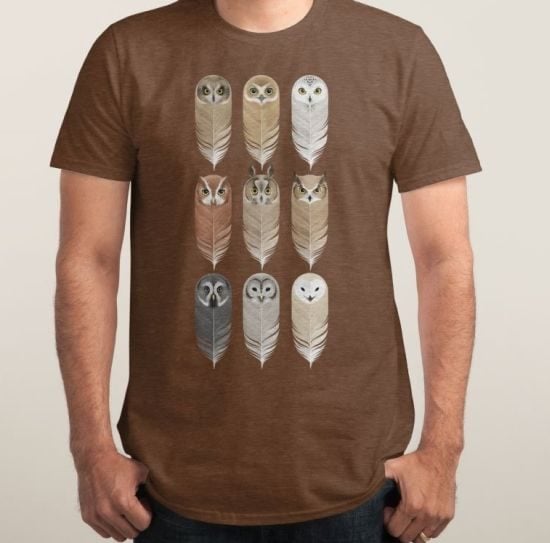
Birders will immediately recognize at least some of the owl faces shown on this owl shirt. Non-birders will just admire the clever design!
Discover 13 fun facts about owls.
2. A Parliament of Owls
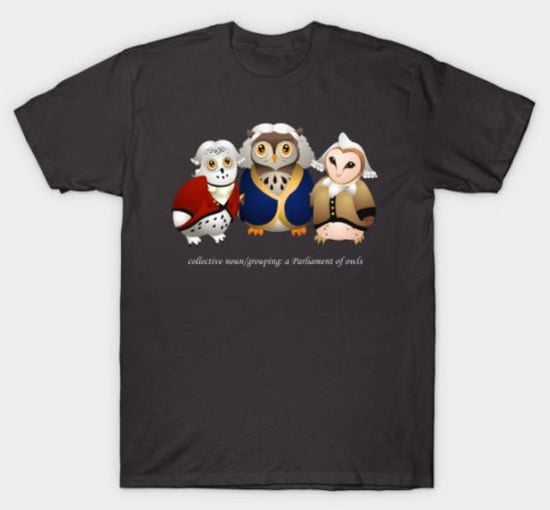
Here’s a little clever wordplay to make you hoot! A group of owls is known as a “parliament,” so what better way to show them than dressed in their proper wigs and coats? It’s the perfect shirt for a birder who’s also a history buff.
Learn more about burrowing owls.
3. Snowy Owls Shirt
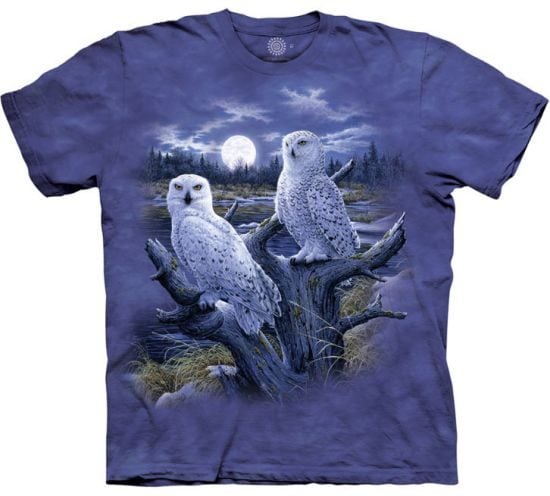
Possibly one of the best-known species, snowy owls never fail to amaze and astonish. Two of these magnificent creatures are featured on this owl shirt, with a rising moon behind them.
4. Nightwatchers

The simplicity of the silhouettes on this owl shirt makes the eyes peering out from the darkness particularly effective.
Learn about barn owls: nocturnal birds of prey.
5. Owl ID Guide

Not sure which owl you’re seeing? Just check your owl shirt! (Unfortunately, it can’t help you ID your owl by sound.) This nifty tee has many North American owls on it, including the great horned, snowy and barred. Seven colors and a variety of styles are available.
Here’s your guide to the amazing owls in North America.
6. Find 11 Owls
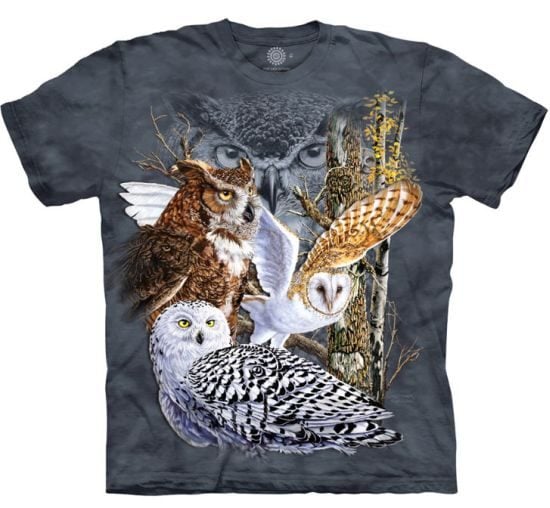
Here’s another shirt for those who love realistic illustrations. As the name says, there are 11 owls on this shirt. Can you find and name them all?
Here’s how to attract owls to nest in your yard.
7. Stringiform

We’ve got another pun for you: in taxonomy, owls make up the order “Strigiforme.” Not everyone who sees this owl shirt will get the play on words, but they’ll enjoy this inventive design.
Don’t miss these adorable baby owl pictures.
8. Winter Forest Owls

This owl shirt features another subtle design, an owl silhouette revealing a snowy winter forest scene.
Learn how to identify eastern and western screech owls.
9. Birdorable Owl Shirts
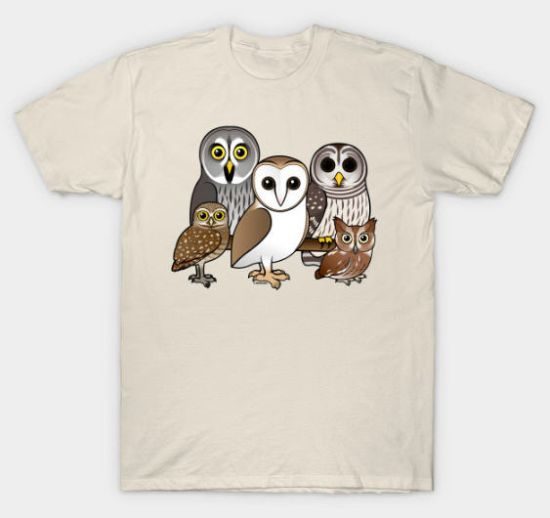
This cute owl shirt boasts recognizable species in an adorable style! It’s a fun combination of nature and art.
Learn all about great horned owls.
10. Owls of the Nile
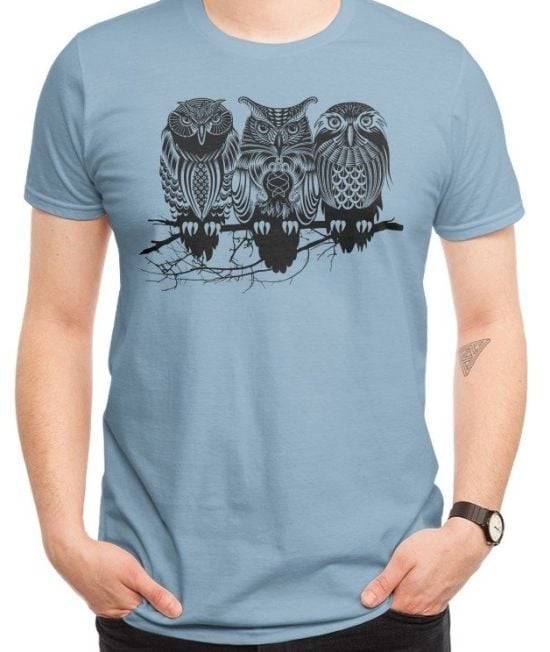
In this shirt’s stylized design, owls are combined with beautiful patterns and symbols. It’s an elegant choice for any owl fan.
Psst—northern saw whet owls are the cutest owls.
11. Dramatic Owl

Anyone who finds owls some of the most majestic birds will love these owl shirts. An owl looks truly regal as it perches on a branch in this design, which can be printed on 20 colors and in sizes XS to 3XL.
Learn how to spot the owl in your backyard trees.
12. Early-Bird Owl

It’s easy to be a morning person if an owl this cute greets you with your coffee! This super-adorable shirt design features an owl standing on a cup of coffee (or tea). It’s available in a ton of different styles, including sweatshirts, V-necks and of course, owl shirts. A wide variety of colors are also available.
Next, check out these fun facts about owls in pop culture.
What Do Baby Birds Eat?

If you watch birds in your backyard in spring and summer, you’re likely to encounter bird mothers and dads feeding their babies. What foods do baby birds eat? It depends on the type of bird.
Some species’ chicks hatch out of the egg with the instinct to find their own food. Young sandpipers and ducklings will start pecking at tiny insects within hours of hatching. Baby quail run after their parents, who show them how to nibble on insects and seeds, and soon the hatchlings begin to find food for themselves.
Discover which birds eat insects, including mosquitoes, butterflies and bees.
But birds that hatch naked sit in the nest and wait for their parents to bring them food. For most songbird nestlings, the diet consists mainly of protein-rich insects, even if the adults tend to be seed-eaters for much of the year. Cedar waxwings bring insects to their young for the first two days, but then start bringing a variety of fruits. American goldfinch babies get a diet of mashed-up seeds. Baby hummingbirds eat a slurry of regurgitated nectar and small insects.
A pair of American robins feeding a hungry family of babies will deliver 100 to 150 meals a day to the nest. Each baby robin may eat its weight in insects, worms and berries every day.
Learn how long baby birds stay in the nest.
How Do Baby Birds Learn to Find Food?
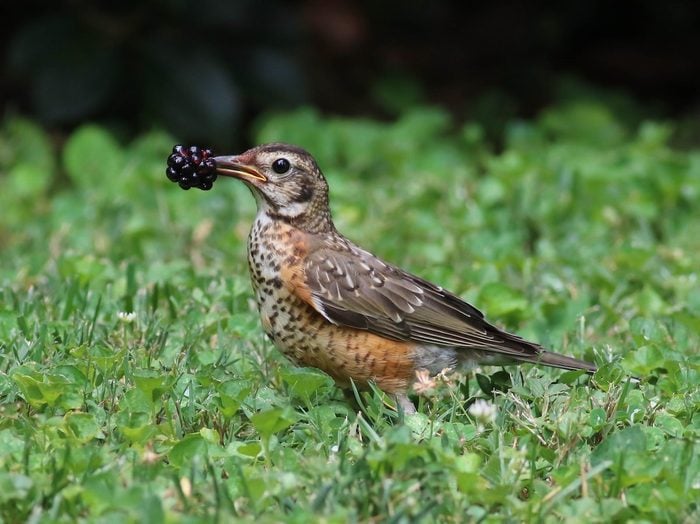
Life is tough for young birds when they’re first apart from their parents. They have to figure out how to find enough food to keep their strength up, while learning how to recognize predators and other potential dangers. If they can survive their first few weeks of independence, however, they have a good chance of living a normal life span.
After young birds leave the nest they may watch how their parents search for food, but mostly they will learn by trial and error, with instinct sharpened by practice.
Support young birds wherever you live by providing native plants, keeping cats indoors and avoiding pesticides to make your yard bird friendly. In return, you’ll get the excitement of watching young birds as they grow up and explore their world.
What is a fledgling? See the stages of a baby bird’s life.
Should You Rescue or Feed a Baby Bird?
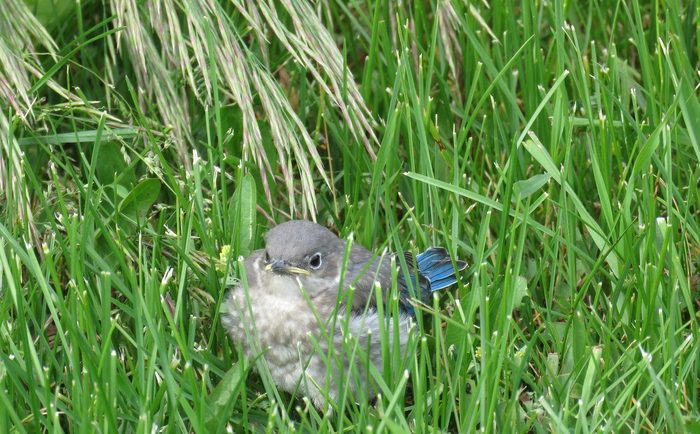
A young bird out of its nest may look like it needs help, but it’s best to back off and observe from a distance. More often than not, the parent birds are nearby. They continue to feed the youngster while it’s on the ground, and if given enough space, lead it to safety.
Of course, if the fledgling is in immediate danger—in traffic or threatened by prowling pets—move the bird to a safer spot. It is a myth that bird parents will reject a young bird if you touch it. The young bird can be placed back in its nest or in the safety of a nearby shrub. Can you move a bird nest?
If a baby bird appears to be injured, contact a local rescue organization or registered wildlife rehabilitator. It is illegal to raise a wild baby bird.
Next, check out super cute pictures of baby birds you need to see.
What’s the Correct Term for Baby Birds?
According to birding experts Kenn and Kimberly Kaufman, it’s fine just to call them babies, chicks or youngsters. To be more specific, a young bird that has just hatched out of the egg is a hatchling, one that’s still in the nest is a nestling and a young bird that has left the nest is known as a fledgling. Here’s a complete breakdown of the stages of a baby bird’s life.
Psst—This is the only bird nesting material you should put out.

Hatchling
A hatching is a baby bird after it hatches from an egg. It usually does not have feathers and its eyes are closed. However, some baby birds are born with feathers. Here’s what you should do if you find a bird nest.

Nestling
A nestling is a bird developing in the nest. This bird is not yet ready to leave the comfort of the nest, cannot fly and needs to be fed by mom or dad. (Learn more about what baby birds eat.) Check out super cute photos of baby birds.

Fledgling or Juvenile
A fledgling is a bird in its first coat of feathers that is capable of moving about on its own. Its feet can grip a branch and it has developed feathers. At this stage, a bird will venture out of the nest and start to learn how to survive without its parents. It has not reached full adult plumage, and the feathers are likely to be loose and soft. A bird in this stage often looks notably different from an adult. No need to be alarmed if you find a bird like this out of the nest—its parents are likely nearby. Psst—this is what a baby hummingbird looks like.

Subadult
The term subadult describes a bird whose plumage is no longer juvenile but not quite adult. It starts to look less like a baby bird at this stage. Learn all about robin nests and robin eggs.
Immature
Any bird that isn’t an adult yet, including those with juvenile or subadult plumages, can be called immature. The term is commonly used to reference large birds like bald eagles and some gulls that don’t achieve full adult plumage until they are 4 or 5 years old.
Are There Different Kinds of Baby Birds?
Definitely! Scientists divide baby birds into two broad types. The first, altricial young, such as those of most songbirds and hummingbirds, hatch naked and with their eyes closed. Scrawny, pink and helpless, they can barely raise their heads at first. The other type, precocial young, such as those of ducks and chickens, are covered with down when they hatch. As soon as they dry off, often within a couple of hours, they are alert, active, and able to get up and walk around.
Next, learn how long baby birds stay in the nest.
Do you live in the desert or have an area in your garden where the sun just beats down relentlessly, making it hard for your plants to survive? Usually these areas are near a wall, which absorbs the heat from the sun, only to re-release it towards your plants making it very difficult for them to grow. Believe it or not, there are beautiful, flowering full sun desert plants that will thrive these areas with reflected heat. Working as a horticulturist, I have encountered many areas like this and have learned what plants will do well and those that don’t. So I thought that I would share some of my favorites that have done very well growing in the Sonoran Desert. Some of these plants can be used in colder climates as well. I have included planting zones and the lowest temperatures that they can survive.
For more picks, check out the top 10 heat-tolerant plants.
Bougainvillea
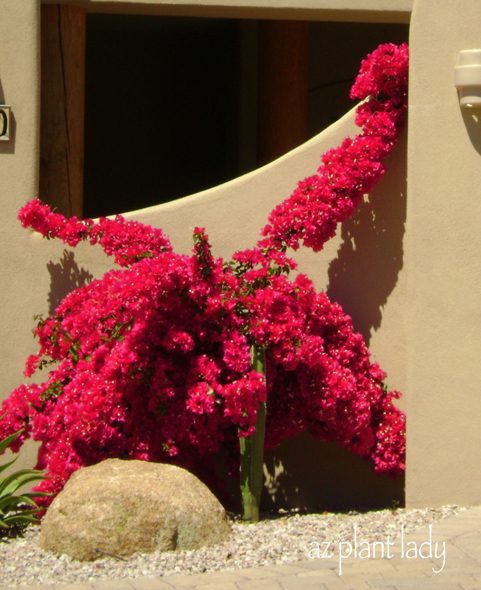
Bougainvillea grows very well in both tropical and semi-tropical climates. Hardy to zone 9 (20 degrees F), they will suffer frost damage, but will recover quickly in the spring once pruned back. The bright color ‘flowers’ aren’t really flowers at all – they are called ‘brachts’ and surround the tiny, cream-colored flower. Bougainvillea can be trained as a shrub or as a vine. They are drought- tolerant, but do best with supplemental water.
‘Green Cloud’ Texas Sage
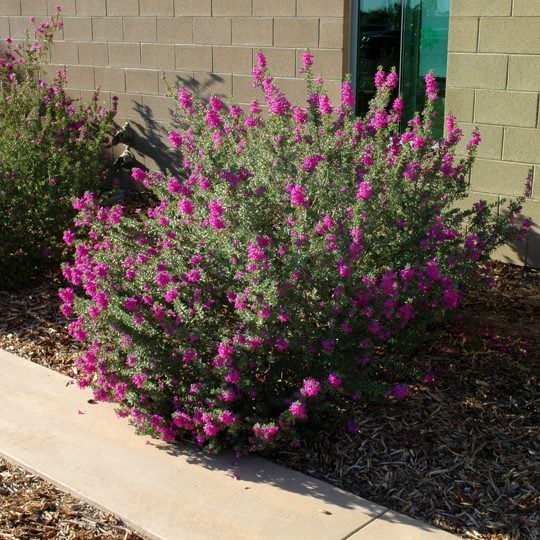
This beautiful flowering shrub is native to the Chihuahuan Desert and produces flushes of purple flowers throughout the summer and fall months. Hardy to zone 7 (10 degrees F), ‘Green Cloud’ Texas Sage (Leucophyllum frutescens ‘Green Cloud’), thrives in areas with hot, reflected sun. Landscapers tend to prune them into ‘balls’ or ‘cupcake’ shapes, removing much of the flowering buds. I recommend pruning back in early spring and then letting them grow into their natural shape.
Discover the desert birds of the Southwest.
Red Yucca
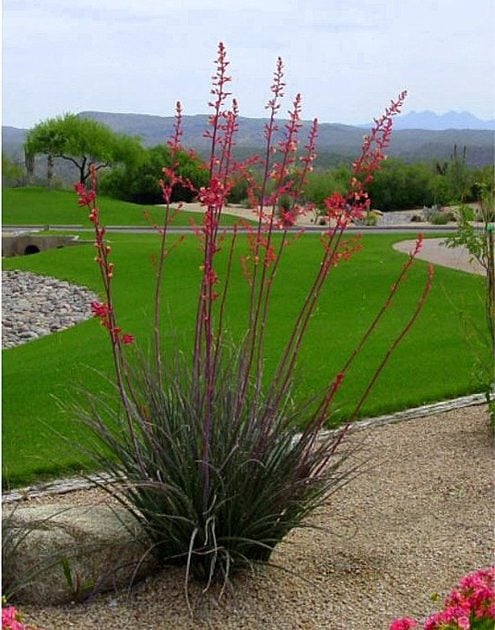
Red yucca (Hesperaloe parviflora) is a beautiful succulent. The leaves look grass-like and in spring, coral colored flowers are produced. They are extremely low-maintenance and drought-tolerant and hardy to zone 5 (-20 degrees F).
Meet the pyrrhuloxia or desert cardinal.
Red Bird-of-Paradise
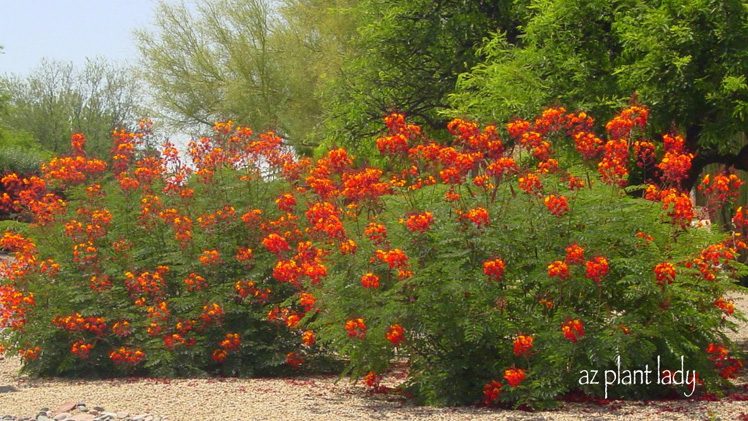
This shrub is a huge favorite. Gorgeous orange/red flowers cover these large shrubs all summer long. Known by different common names, be sure to use the botanical name (Caesalpinia pulcherrima) to make sure you get the right plant. Hummingbirds can’t resist the flowers. Prune back to 1 foot in January. Hardy to zone 8 (15 degrees F).
Desert Cassia
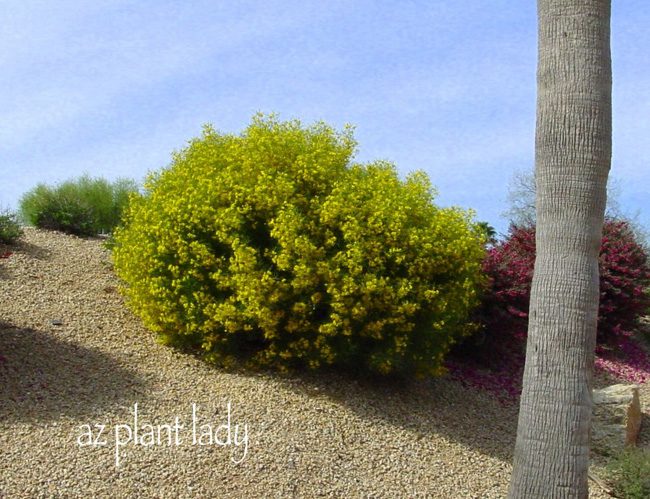
Bright yellow flowers cover desert cassia (Senna nemophila) in the spring. This Australian native is well adapted for dry, arid regions. Prune back once flowering has ended in late spring. Hardy to zone 7 (10 degrees F).
Lastly, I would like to share with you one of my favorite full sun desert perennials.
Desert Marigold
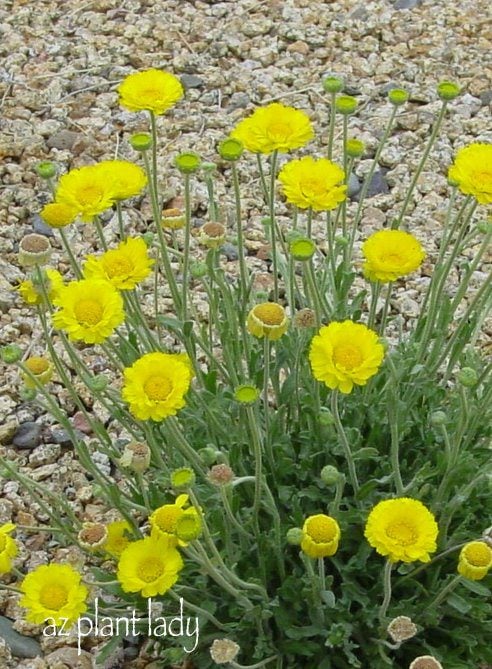
Desert marigold (Baileya multiradiata) is often thought of as a wildflower although it is a perennial. Yellow daisy-like flowers are produced throughout much of the year. Hardy to zone 6 (-10 degrees F), Desert marigold is extremely drought tolerant and can often survive on rainfall alone when started from seed. Cut back twice a year to 6 inches to encourage more bloom. They are rather short-lived, but do self seed.
All of the plants mentioned need to be planted in full sun. No special soil amendments are needed. With the exception of the desert marigold, supplemental irrigation is needed. And so, if you have a bare, sun-baked corner in your garden, I hope you will try one of these sun-loving desert plants.

Shrubs are beautiful, yet functional features of the landscape. We use them to screen bad views, define our property lines, add seasonal interest and, of course, attract birds, butterflies and bees to the garden. However, many of us don’t want to wait for them to reach full size. You can hurry up the process with these fast growing shrubs. (But make sure to select varieties that are good for your zone and growing conditions!)

Fast Growing Shrubs: Elderberry
Sambucus, Zones 3 to 9
Add a few elderberries for you and the birds to enjoy. Butterflies are attracted to the flowers that appear in summer. The small, purple-black fruit that follows attract birds and can be used for jellies, pies, juice and wine. New cultivars like Black Lace and Lemon Lacy add fine texture and color to the landscape.
Why we love it: Elderberries tolerate wet and even dry soil once established.

Panicle Hydrangea
Hydrangea paniculata, Zones 3 to 8 and 9 to 10 on West Coast
The newer and shorter varieties have helped this plant’s popularity explode. Their hearty nature and low-maintenance makes them an easy plant to use as a hedge, in mixed borders or as a specimen. Grow hydrangeas in full to part sun and check the plant tag for proper spacing.
Why we love it: Its close cousin, the Annabelle-type hydrangea, grows quickly and makes a nice addition to shade gardens.

Green Giant Arborvitae
Thuja ‘Green Giant’, Zones 5 to 8
Arborvitae is a popular evergreen for screening and hedges. This hybrid matures to more than 40 feet tall and 12 feet wide. Plan accordingly! Here’s another tip—break out the pruners and do regular snipping to contain its growth. It does great in full sun or part shade.
Why we love it: This arborvitae tends to stay greener than most in winter.
Check out the top 10 dwarf conifers for small spaces.

Ninebark
Physocarpus opulifolius, Zones 2 to 8
New cultivars with colorful foliage have moved this native plant out of the back border and into the spotlight. Use as a hedge, backdrop for flowers or in mixed borders. This tough fast growing shrub tolerates full sun to part shade, drought, salt, clay and rocky soils.
Why we love it: You can find lots of compact cultivars like Lady in Red (Ruby Spice), Nugget, Little Devil and Amber Jubilee.
Check out 10 shrubs with pink flowers.

Fraser Photinia
Photinia x fraseri, Zones 7 to 9
This is an evergreen shrub often used as part of a screen or tall hedge. Its bright red ends have inspired its other common name—red tip. Regular pruning controls the plant’s size and promotes new growth. White flowers appear in spring and though they’re pretty to look at, they’re not pleasant to smell. Be aware that these fast growing shrubs are invasive in some parts of Texas.
Why we love it: Red Robin photinia tends to be less susceptible to leaf spot diseases.

Glossy Abelia
Abelia x grandiflora, Zones 5 to 9
Add some fragrance and color with this sweet fast growing shrub. Fragrant, bell-shaped flowers first appear in spring and continue throughout the growing season. The season ends with purplish fall foliage. Grow in full sun for the best flowering and fall color. Use en masse, as a hedge, in natural areas or in front of larger plants and evergreens.
Why we love it: This low-maintenance plant has few pest problems.

Hazelnut
Corylus Americana, Zones 3 to 9
This easy to grow native shrub grows in full sun to part shade and moist to dry soils. The edible fruit can be roasted and eaten if you can harvest the nuts before the birds and squirrels do. Use as a screen or hedge in informal or natural areas where it has room to spread.
Why we love it: The pendulous male flowers (catkins) provide added interest in late winter or early spring.

Waxmyrtle
Myrica cerifera, Zones 7 to 11
This native tree is often pruned and used as a fast growing shrub. It’s easy to grow and tolerates a wide range of soil conditions, including drought and flooding. Northern gardeners can grow its hardier relative, Bayberry (Myrica pennsylvanica).
Why we love it: The evergreen foliage is fragrant when crushed, and the gray berries are an energy source for winter birds like yellow-rumped warblers.

Japanese Beautyberry
Callicarpa japonica, Zones 5 to 8
The striking violet to almost metallic purple fall fruit make these fast growing shrubs worthy of a spot in the shrub border. The blue-green leaves make a nice backdrop for both the pinkish white flowers and fruit. It grows best in full sun or light shade in well-drained soils.
Why we love it: The birds love the fruit of both this and its southern cousin, American beautyberry, which is hardy in zones 6 to 11.

Yaupon
Ilex vomitoria, Zones 7 to 10
These native evergreen fast growing shrubs form dense thickets well suited for screens, hedges, windbreaks and barriers. Yaupon can be espaliered or trained as a small tree or topiary. The red berries brighten the winter landscape and provide food for the birds.
Why we love it: Its adaptability, along with drought- and disease-tolerance, makes it a long-lived native alternative to boxwood.
Check out more berry bushes that bird lovers should grow.
What Does It Mean When You See a Swallow?

There’s no doubt that swallows are gorgeous birds. From the tree swallow’s iridescent turquoise plumage to the barn swallow’s handsomely contrasting rust and blue, seeing a member of the swallow family always invites admiration. But do swallow sightings have a deeper significance? Here’s what you need to know about the swallow bird meaning.
“This tree swallow (above), and its companion, took up residence in my backyard. I would watch them day and night. It was amazing seeing these birds,” says Birds & Blooms reader Sonja Mauk.
Learn 8 types of swallow birds you should know.
Swallows in Ancient Greece
Significance and symbolism for swallows dates back thousands of years. In Ancient Greece, swallows were associated with Aphrodite. In addition, they were bearers of good luck. The ancient Greeks allegedly believed gods could take new form as swallows, and harming one of those birds could bring bad fortune.
Did you know—tree swallows use bluebird houses!
Swallow Tattoos for Sailors at Sea
Swallows also have significance for travelers on the sea. Surprisingly, these birds became something of a status symbol for sailors, and a sign of good luck. According to tradition, a sailor with more than 5,000 miles on the waves earned the right to have a swallow tattooed on them. At 10,000 miles, they’d be eligible to add another swallow bird.
Cliff swallow vs barn swallow: spot the differences.
Swallow Bird Migration Meaning
In modern times, swallows are typically associated with spring and summer — especially in China. The swallow’s migration and re-appearance often coincides with winter’s end. The birds usher in a brighter, more colorful season. For that reason, these birds are symbols of good luck or positive change.
Look for a violet-green swallow in the west.
Birders’ Encounters With Swallows

“Barn swallows returned to their nest above our front door after raising four hatchlings the previous summer. The three young barn swallows in the picture are the second clutch our feathered friends, affectionately referred to as Beatrice and Banks, produced this summer. Watching Mom and Dad take care of their young became a large part of my wife’s and my pandemic activities and inspired us to take up birdwatching. This image was taken during one of many hours-long sessions sitting under a patio umbrella in our driveway. These birds have become our welcome housemates, and we look forward to seeing them next year,” Birds & Blooms reader Daniel Grundmann says.
Learn about swallows nest types and nesting habits.

“I moved to a house close to the Blue Ridge Parkway a few years ago. I had a couple of birdhouses that my dad made for me that I hung up, but I never saw birds around them. One spring, I noticed this beautiful blue tree swallow made a nest in one of them. My dad had passed away a couple of years ago. He crafted lots of birdhouses, and he loved to watch the birds. Seeing this bird and having this picture makes me remember my dad. I am thankful he passed his love of birdwatching to me,” Birds & Blooms reader Pattie Turner says.
Baby swallows are too cute! Check out these ultra-adorable photos of baby swallows.
Why the Blue Jay Range is Moving West

With its distinct blue and white plumage, black necklace and pointed crest, a blue jay is hard to miss. Feisty, loud and intelligent members of the corvid family, this species is commonly seen in the eastern half of the United States. But now the blue jay range is expanding, and these birds are taking center stage in more western backyards.
Traditionally at home in eastern deciduous forests, blue jays feed on both seeds and insects. While they thrive on acorns, their versatile diet allows them to easily expand their territory to new habitats.
As more people moved west, they planted trees and put up bird feeders, creating ecological stepping stones, according to Tim Meehan, a quantitative ecologist for the National Audubon Society. “Blue jays started hopping from one yard to the next,” he says.
Tim says, looking at more than a century of data collected during the Christmas Bird Count, blue jays started to appear in the western regions by the 1960s. They’re now full-time residents in many of these areas, with reports of them venturing to the coast and as far north as Washington and British Columbia.
Meet 8 types of jays you should know.
Blue Jays on the Move
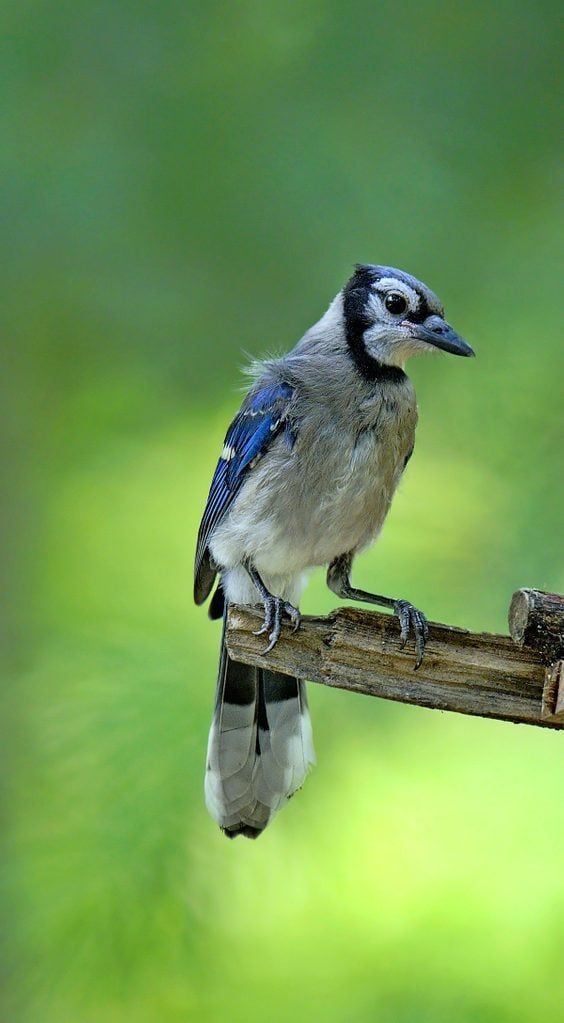
Often mating for life, blue jay pairs build their nests 10 to 25 feet high in the outer branches of trees.
These jays are highly territorial and will dive-bomb anything that enters their domain that they may consider a threat.
“They’re all over Boulder, Colorado, during the breeding season from March to August,” says Tim about his hometown. “After that, there’s pressure on the youngsters to go find their own habitat.” This behavior causes the jay’s range to slowly expand.
“In the winter, you see a similar pattern,” says Tim. Blue jays do not migrate long distances as other songbirds do. But in some areas, such as the Canadian provinces, they’ll move south. They often remain in areas with mild winters. Tim adds, “They only move when there’s good reason to.”
To encourage backyard blue jays, install feeding platforms near shrubs for cover. Stock the platforms with peanuts, fruit, sunflower seeds and mealworms. Suet feeders are also a hit.
It’s equally beneficial to include trees, such as American beech or native oak trees, in your landscape to provide a supply of food and a safe place to nest. Bird baths are always well received, particularly in regions with little rain.
Bluebird vs blue jay: How to tell the difference.
Steller’s Jays vs Blue Jays
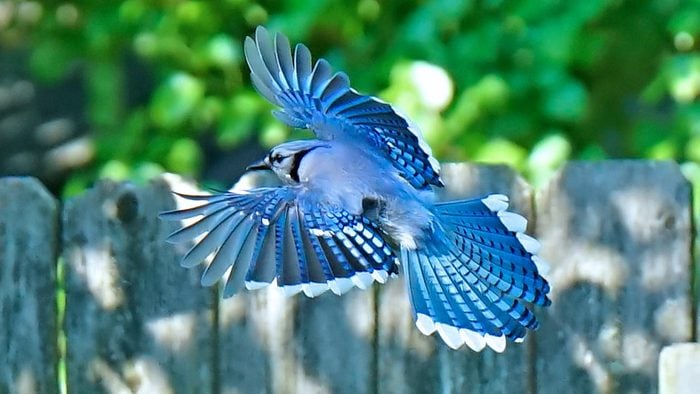
The good news is that the blue jay’s expanded range does not appear to affect other members of the corvid family that are already established in the West, like Steller’s jays. Because blue jays occupy a different type of habitat, they fill an empty niche.

Steller’s jays have a similar appearance to blue jays, but the big difference comes in their coloring—blue jays show off bright blue and white feathers, while Steller’s jays have a darker look on their heads and a darker blue body and tail.
Also look for California scrub-jays on the West Coast.